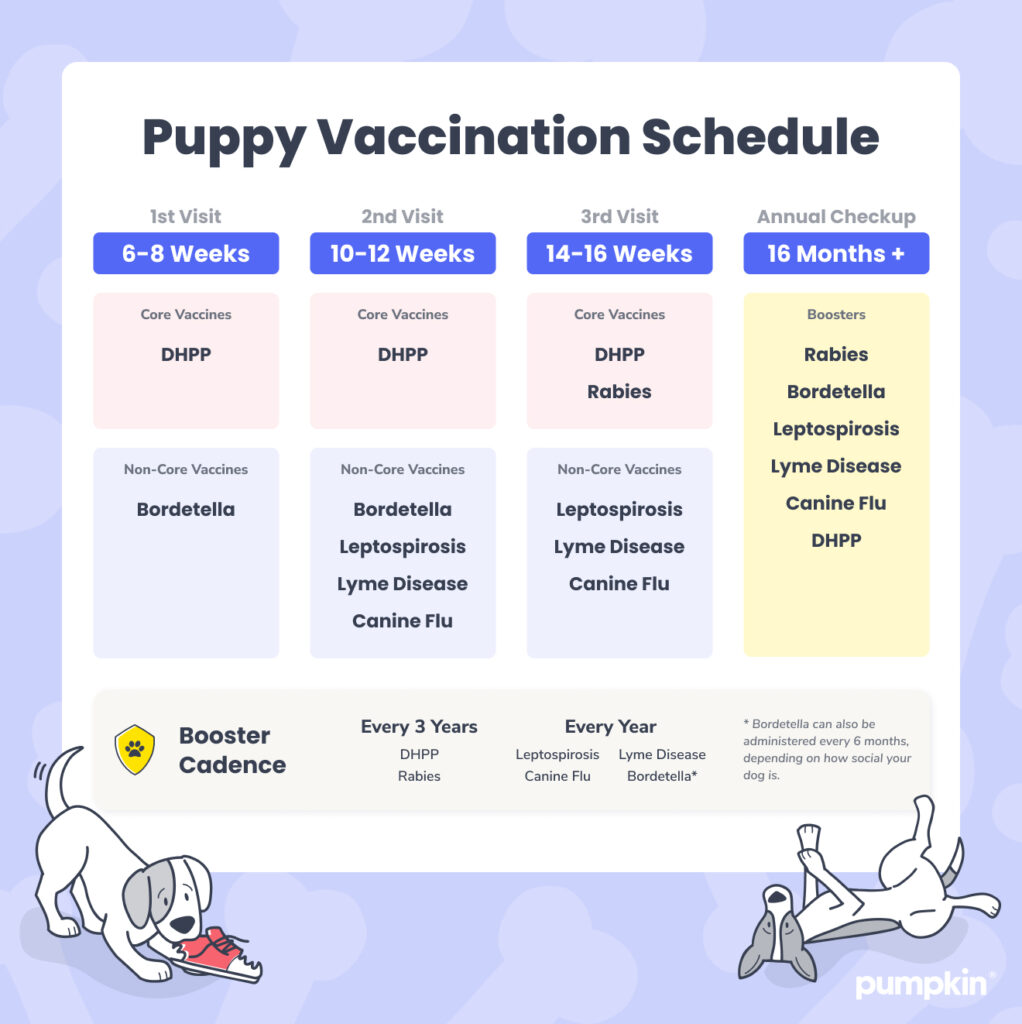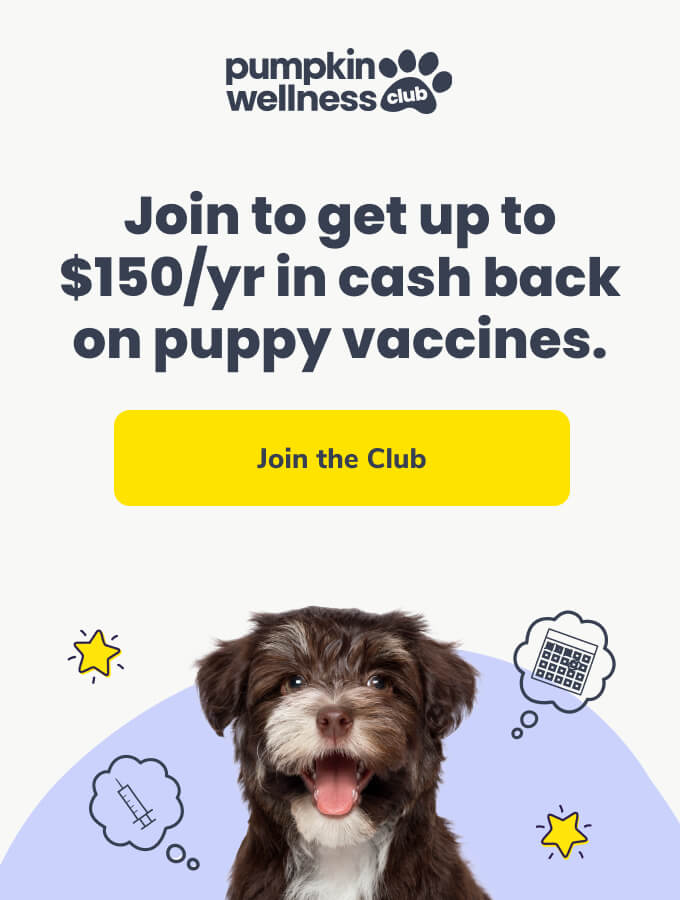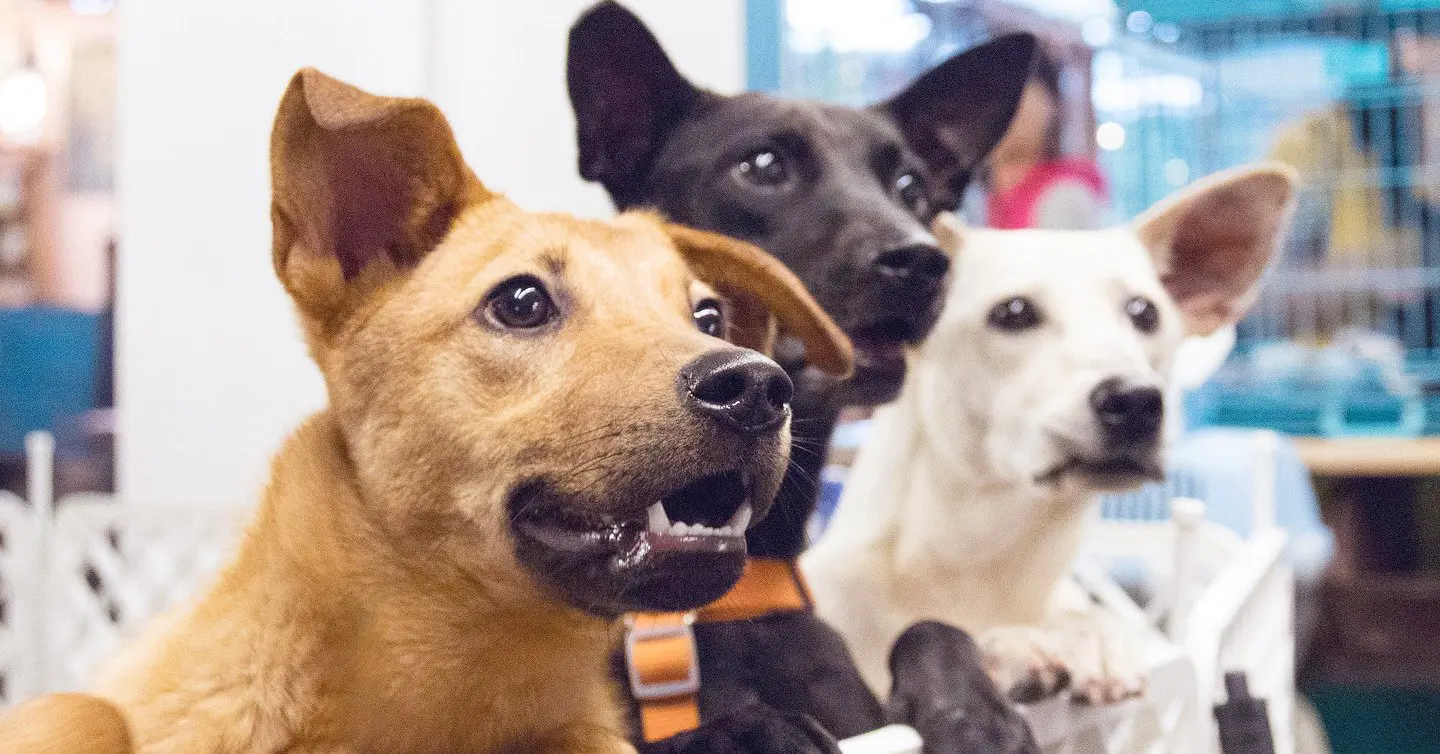Key Points
- A puppy’s vaccination schedule typically begins at 6-8 weeks of age, with core vaccines including canine distemper virus, adenovirus-2, parvovirus, parainfluenza virus, and rabies.
- Check with your vet to learn if your pup should get additional non-core vaccines, such as bordetella and leptospirosis.
- Want to save on dog vaccines? Join the Pumpkin Wellness Club* and you can get up to $150 in cash for your dog’s yearly vaccinations — and that’s just one of many membership benefits.
Bringing a new puppy into your world is an exciting experience. Your days soon become filled with playtime, walks, cuddles, and boundless puppy energy — and inevitably, visits to your veterinarian. Vet visits might not be as fun as playing tug-of-war, but who wouldn’t want to provide the best possible care for their newest and furriest family member?
Scheduling wellness check-ups with your vet is an important part of those first few months of puppy parenthood. During these visits, your veterinarian will check on your puppy’s growth and general health, answer your questions about diet and exercise, and provide essential procedures like deworming and vaccinations.
But which vaccines should your pup get? And at what age? We’re covering everything you need to know about vaccines for your puppy. Keep scrolling to view and save our official puppy vaccination schedule.
Get help paying for puppy care
Routine care in your puppy’s first year is crucial, but it can also be pricey. Even the best puppy insurance plans won’t cover routine care like this. So, a great way to make your pup’s veterinary costs more manageable is to join the Pumpkin Wellness Club, a new program that helps pet owners get cash back to save on routine veterinary care like annual checkups, vaccinations, health screenings, and more.
Members of the club can get up to $150 in cash back for vaccinations each year and save as much as $460 per year on routine care overall. Members also get access to a 24/7 Pet Health Helpline, plus perks like special discounts on top pet brands.
How do puppy vaccines work?
Imagine your pup’s immune system is as young and defenseless as, well, a puppy. Your dog hasn’t spent much time out in the world yet, and their immune system is still learning how to fight off infectious diseases. Vaccines are essential for protecting your puppy against common pathogens that could make them quite sick.
By mimicking disease-causing microorganisms, vaccines activate your pup’s innate immune response without actually making them sick. This helps build up their defenses and prepares them for future exposures to potentially lethal disease-causing agents.
“Vaccines play a crucial role in your puppy’s early health care. Their significance cannot be overstated. Through vaccination, your pet’s vet does not only shields your pup from potentially deadly diseases. The vet also protects other animals and people in the same household.”
– Charles A Hurty, DVM Grove Veterinary Clinic
Like humans, puppies need several successive vaccinations (or booster shots) to protect them against contagious diseases. Following the recommended schedule for vaccinations and boosters is key, as these repeated exposures are essentially training classes for your pup’s immune system.
When should I start my puppy’s vaccination schedule?
Your puppy’s vaccination schedule should begin at 6-8 weeks of age, with booster shots administered every 2-4 weeks until around 4 months of age.
It’s crucial to start your puppy’s vaccinations before their natural immunity dwindles. Puppies initially receive protective antibodies through their mother’s milk, but this protection wanes over time, especially if puppies are separated from their mother shortly after birth.
A solid first-year vaccination schedule is just the first step toward lifelong immunity against common diseases. Keep in mind that many core and non-core vaccines need to be followed up with yearly booster shots.
What core vaccines do puppies need?
The American Animal Hospital Association (AAHA) breaks down their canine vaccination guidelines into two categories: core vaccines and non-core vaccines. Core vaccines are recommended for all young dogs based on the overall risk of exposure, transmissibility to humans, and severity of the disease.
So, what shots do puppies need? According to the AAHA guidelines, core vaccinations for puppies include:
Canine distemper virus
Canine distemper virus is a highly contagious virus that spreads through contact with infected dogs. It is responsible for causing the often fatal disease known as distemper.
Distemper symptoms include:
- Diarrhea
- Vomiting
- Coughing
- Eye and nose discharge
- Seizures
Unfortunately, there is no known cure for canine distemper, which is fatal in one out of every two dogs. This means prevention through vaccination is a must. Your puppy’s vaccine schedule should include a series of distemper vaccinations until your pup is around 16 weeks old, a first-year booster, then regular boosters every three years. This vaccine is also included in the combination DHPP vaccine, which protects dogs from four common diseases.
Adenovirus-2
The adenovirus-2 vaccine defends against two strains of the virus: CAV-1 and CAV-2. While CAV-2 causes the infamous kennel cough, CAV-1 causes hepatitis. Since other pathogens (disease-causing organisms like viruses and bacteria) can also cause kennel cough, veterinarians prioritize guarding your dog against the hepatitis virus caused by CAV-1.
This viral disease inflames the liver and spreads through bodily waste (feces, urine, and saliva). It also spreads through eye and nose discharge from infected animals.
Watch out for symptoms like:
- Watery discharge from eyes and nose
- Congestion
- Slight fever
- Loss of appetite
- Cloudy eyes
- Yellow (jaundiced) ears, gums, and skin
- Severe depression
Early vaccination is crucial, as your puppy’s maternal antibodies for CAV-1 begin to fade between 5–7 weeks of age.
Parainfluenza virus
Parainfluenza causes dangerous and highly contagious respiratory infections in dogs, which can manifest as a common cold or something more serious. Like some adenoviruses, the canine parainfluenza virus can also cause kennel cough (although it’s not the main culprit). As the name ‘kennel cough’ would suggest, coughing is the most common symptom of a parainfluenza infection.
Other signs may include:
- Runny eyes or nose
- Loss of appetite
- Wheezing
Symptoms tend to be more severe when another respiratory pathogen is involved along with parainfluenza (more on that later). Kennel cough is treated with cough medicine and sometimes antibiotics.
This virus thrives in places bustling with other furry pals, including kennels or dog parks. For this reason, some dog boarding facilities require dogs to get an additional non-core vaccine to protect against kennel cough. To prevent this disease, make sure your pup’s vaccinations are up-to-date before hitting the dog park or doggie daycare!
Parvovirus
Canine parvovirus, also called “parvo,” is another contagious viral disease. This disease affects the gastrointestinal system, immune system, and heart muscles. Parvo also spreads through the feces of infected dogs — one of many reasons why cleaning up after your dog is so important.
Parvovirus is especially dangerous for puppies, especially unvaccinated dogs younger than one year of age. Watch out for symptoms like vomiting, diarrhea, and loss of appetite as possible signs of parvo. Most infected dogs require hospitalization and intensive inpatient treatment to recover.
Tip: The four viruses listed above are usually addressed with a combination vaccine. At the veterinary hospital, these all-in-one injections may be called any of the following by your vet:
- DHPP
- DAPP
- Distemper vaccine
In other cases, your vet may administer parainfluenza vaccinations separately from the other three. The parainfluenza vaccine may also be combined with the Bordetella vaccine, since both pathogens are common causes of kennel cough.
Rabies
Rabies is a deadly disease that doesn’t play around. Once a rabies infection takes hold, there is no cure. This viral disease is transmitted through the bites of infected mammals, and it’s as contagious and life-threatening for humans as it is for dogs.
Once inside your dog’s body, the rabies virus attacks the nervous system. You may notice symptoms like:
- Foaming at the mouth
- Drooling
- Paralysis
- Difficulty swallowing
- Aggression
While there is no treatment for rabies, it is easily preventable with a rabies vaccination. In fact, this vaccination is so essential that most state laws require rabies vaccines for household pets.
Non-core vaccines
Non-core vaccines are not recommended for all dogs, but your veterinarian may recommend them based on your puppy’s lifestyle, location, or existing health conditions. For example, if you plan on taking your puppy along on camping or hiking trips, your vet may recommend the canine Lyme disease vaccine; if you live in rattlesnake country, your vet may recommend the Crotalus atrox vaccine to prevent rattlesnake poisoning.
Tip: If you plan on boarding your puppy or sending them to daycare, some facilities may require certain non-core vaccines for highly contagious dog diseases.
Non-core vaccinations for puppies include:
Bordetella bronchiseptica
Bordetella bronchiseptica is the number-one bacterium behind most cases of kennel cough (basically, whooping cough for dogs).
If your dog loves to rub noses with other pups — at daycare, dog parks, or training classes — this may as well be a core vaccine. Many boarding facilities and training schools will ask to see proof that your dog received the bordetella vaccine. Veterinarians can administer the bordetella vaccine by itself, or they may pair it with the parainfluenza vaccine for extra protection.
Leptospira
Leptospira is a bacterium that causes leptospirosis, a disease that can affect your dog’s liver and kidneys. Leptospirosis is often spread through water or soil that has been contaminated with animal urine — and it is also contagious for humans.
Although leptospirosis is historically more common in wooded areas populated with rodents and raccoons, it has been increasingly seen in suburban neighborhoods.
Symptoms range based on the severity of the disease. Fortunately, leptospirosis is treatable with antibiotics, but you should still watch out for:
- Fever
- Lethargy
- Jaundice
- Vomiting
- Diarrhea
- Excessive drinking
If your dog enjoys splashing around in lakes and rivers or sniffing about farms, or if leptospirosis is known to be a problem in your area, the lepto vaccine is probably a good idea. This vaccine can help protect your pup from unseen risks during outdoor adventures. Some hospitals may actually consider this vaccine a core vaccine in their vaccination protocol, since the disease is more commonly reported these days.
Borrelia burgdorferi
Borrelia burgdorferi is the bacterium that causes Lyme disease. This disease is transmitted through a tick’s bite, most commonly the deer tick.
Lyme disease also poses a risk to humans, but it can be harder to detect in dogs. Symptoms in dogs typically include:
- Fever
- Lethargy
- Refusal to eat
- Limping
Your vet will prescribe antibiotics to treat Lyme disease if they believe your dog is infected. Testing for the disease is tricky, so many professionals will diagnose it based on symptoms in order to treat it early. If left to progress, Lyme disease can advance to a form of kidney disease called Lyme nephritis, which requires intensive therapy to treat.
Your vet may recommend a Lyme disease vaccine if you and your pup live in a tick hotspot, such as the northeastern United States, or if you spend a lot of time hiking through the woods. However, this does not mean that you should opt out of a monthly tick preventative. The best way to protect your dog from Lyme disease exposure is to prevent both tick bites and the progression of the disease.
Canine influenza virus (H3N8 and H3N2)
Canine influenza (not to be confused with parainfluenza) is a respiratory disease caused by the influenza A virus. The virus spreads through the air, contaminated objects, or direct contact with a sick dog. Sound familiar? Just like humans, dogs can get the flu — and the flu vaccine.
Symptoms of dog flu include:
- Coughing
- Nasal discharge
- Fever
- Lethargy
- Reduced appetite
Similar to their human companions, dogs usually recover from the flu within a few weeks with plenty of fluids and rest. To protect your pup from all strains of flu, two forms of the dog flu vaccine are available: H3N8 and H3N2. The AAHA recommends that at-risk dogs receive both forms of the vaccine.
According to the AAHA guidelines, risk factors include frequent visits to the dog park, daycare facilities, groomers, dog shows, and other gathering spaces for four-legged friends. So, if your pup has a busy social calendar, make sure you schedule a canine influenza vaccination to keep them safe.
Crotalus Atrox
If you live in rattlesnake territory and your pup loves to roam the great outdoors, you may want to consider the Crotalus atrox vaccine. This shot protects your dog against sickness caused by a rattlesnake bite.
If your dog gets bitten by a rattlesnake, the toxin can cause fatal symptoms. Look out for:
- Excessive drooling
- Panting
- Restlessness
- Collapse
- Diarrhea
- Lethargy
- Swelling
Now, this vaccine doesn’t offer complete immunity from rattlesnake poisoning, but it can decrease the severity of clinical signs. So, even if your dog is vaccinated, always seek emergency veterinary care if a rattlesnake bites your dog.
Puppy vaccination schedule
Now that you know about core and non-core vaccines, here’s how they all might fit into a puppy vaccine schedule. Please note that you should always consult with your veterinarian for vaccine recommendations, as protocols may change as more research becomes available.

At 6 to 8 weeks:
- DHPP combination vaccine. Booster shots are given at intervals of 2-4 weeks until your puppy is around 16 weeks of age. After the final shot in the series, your dog should receive another vaccine one year later, and a booster every three years after that.
At 12 to 16 weeks:
- Canine influenza vaccine. As early as 6-8 weeks of age. Two shots are required, with 2-4 weeks between them.
- Bordetella vaccine: 8 weeks of age for a single vaccine (or earlier if combined with parainfluenza).
- Leptospirosis vaccine: As early as 8 weeks of age, with a second dose 3 weeks later.
- Lyme disease vaccine: As early as 8 weeks of age, with a second dose 3 weeks later.
- Rabies vaccine: 12-16 weeks of age
Once your dog has finished their initial round of puppy shots, they’ll need booster shots every one to three years, depending on the type of vaccine.
For non-core vaccines, like Bordetella or canine influenza, your dog’s need for vaccination may change as their lifestyle changes.
When you bring your pup to the vet, be sure to ask about their recommendations for vaccinations, testing, deworming, heartworm prevention, and spaying or neutering your dog. This conversation can help you create a customized plan for your new puppy’s needs.
How much do puppy vaccines cost?
The cost of puppy vaccines can vary based on your location, veterinary practice, and the type of vaccine. A single vaccine for your pup may range in price from $15 to $50, or you might pay a single, combined fee for all required vaccines. Some veterinarians may even bundle in the cost of an examination, deworming, or other puppy firsts.
Vaccines make up just one portion of the expenses you’ll have to pay in your puppy’s first year of life and beyond. A routine wellness visit for a new puppy can cost up to $300 when you factor in necessary shots and bloodwork (and you’ll need multiple visits in the first year).
Joining the Pumpkin Wellness Club is a great way to help you budget your dog care costs. For as low as $19.95 per month, you can get paid cash towards your pup’s vaccinations, bloodwork, and other routine preventive care — including the annual wellness exam fee. All in all, members can save up to $460 every year on puppy preventive care and other benefits, such as access to special discounts on top pet brands.
Risks of vaccines for puppies
As with all medical procedures, there are some risks associated with puppy vaccinations. But these risks are extremely minor compared to the benefits of preventing deadly diseases and transmitting them to other dogs and humans.
“I like to say that the most rewarding side effect of puppy vaccination is a healthy adult dog. We have access to extremely safe immunization products, and new technology has delivered vaccines that are increasingly effective at protecting our beloved companions.“
– Charles A Hurty, DVM Grove Veterinary Clinic
Most puppies sail through their vaccinations with no issues. Some pups will experience mild side effects, which can include loss of appetite, localized swelling, or malaise. Not to worry: Vaccine side effects in dogs usually resolve quickly after the initial vaccination.
However, if your pup experiences more severe symptoms after a vaccination — like vomiting, hives, severe pain, or a swollen face — call your vet. They can provide the care your pup needs to feel better in no time.
Planning for a healthy future
We all want the best for our canine companions. Ensuring they get the right puppy vaccines is one of the most important steps you can take to keep your dog healthy.
Once your pup has had their initial vaccinations, you still need to keep their shots up-to-date and schedule regular check-ups with the vet. Plus, your vet can help you create a customized plan for your pup’s health and wellness. That includes choosing the best dog food, exercise routine, and socialization.
Puppies & vaccines: FAQs
- https://www.aaha.org/resources/2022-aaha-canine-vaccination-guidelines/
- https://www.avma.org/resources-tools/pet-owners/petcare/canine-distemper
- https://www.merck-animal-health-usa.com/condition/canine-adenovirus-type-2
- https://vcahospitals.com/know-your-pet/parvovirus-in-dogs
- https://www.avma.org/resources-tools/one-health/rabies
- https://www.avma.org/resources-tools/pet-owners/petcare/lyme-disease-dogs
- https://www.aaha.org/aaha-guidelines/2022-aaha-canine-vaccination-guidelines/key-vaccination-considerations-by-antigen/bordetella-canine-parainfluenza-and-canine-influenza/
- https://www.aaha.org/resources/2022-aaha-canine-vaccination-guidelines/rattlesnake-toxoid/
- https://www.usnews.com/insurance/pet-insurance/how-much-does-a-vet-visit-cost
DISCLOSURE






